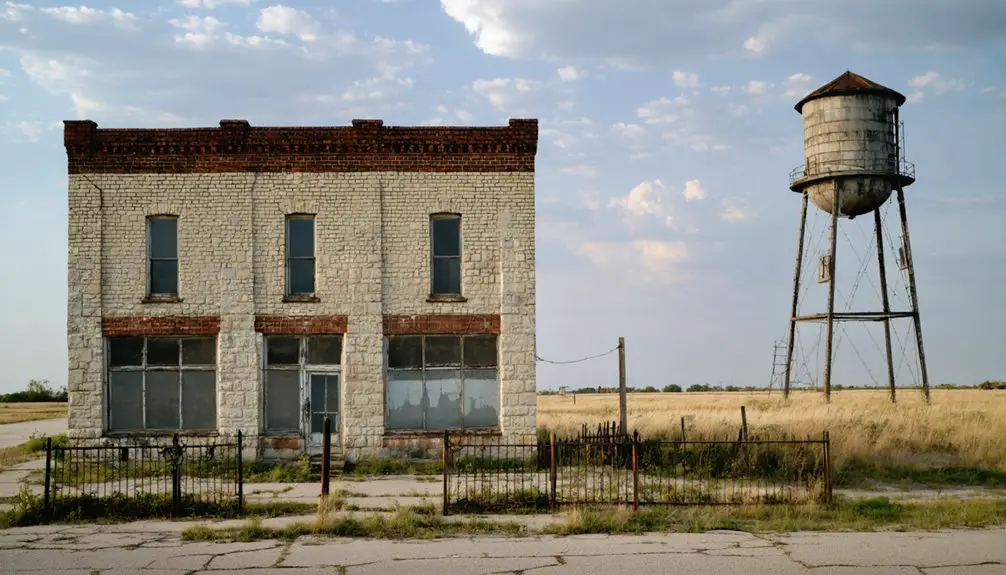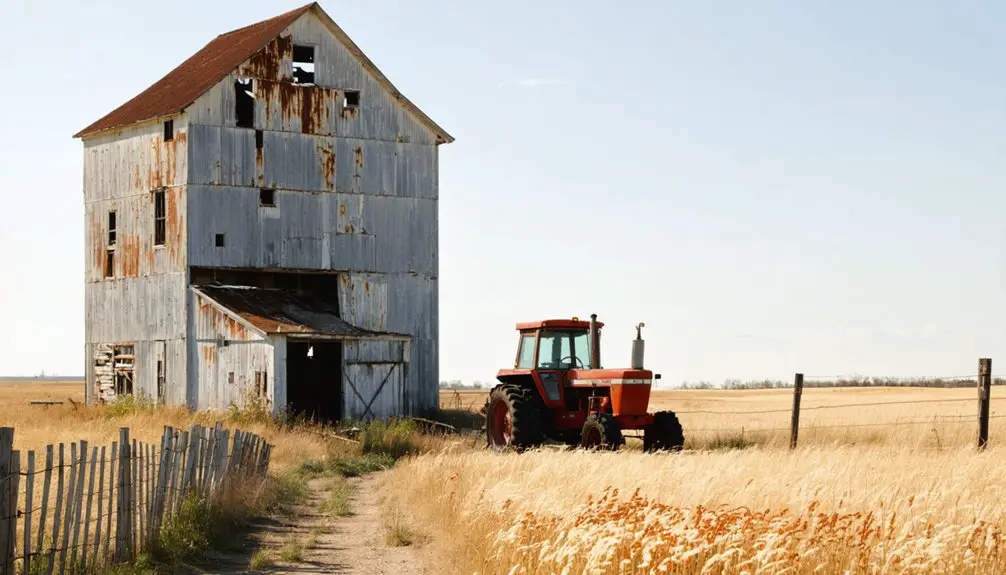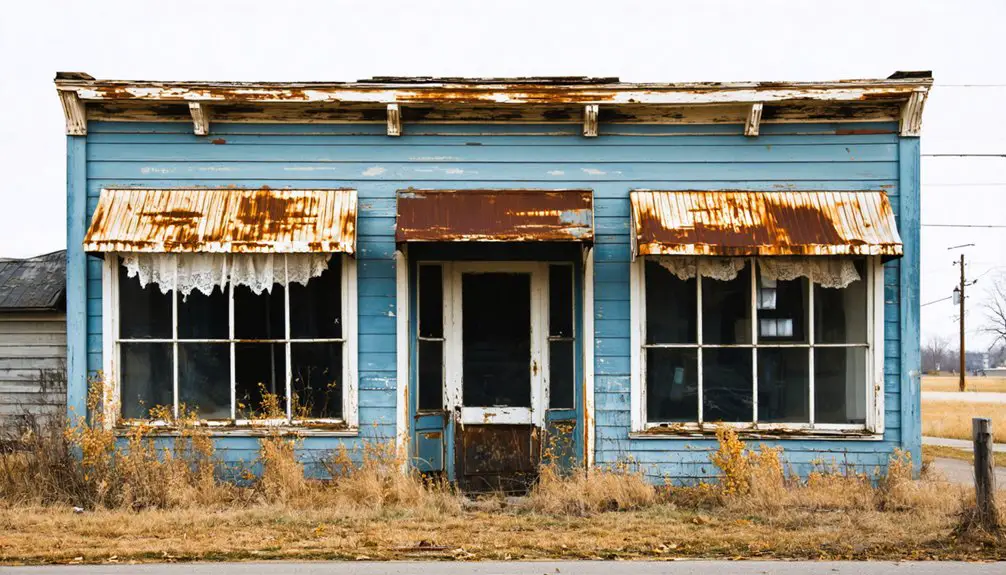You won’t find a typical ghost town in Lecompton, Kansas – instead, you’ll discover the fascinating remains of what was once Kansas Territory’s capital and most politically influential city. While it’s no longer the bustling pro-slavery stronghold of the 1850s, this historic town still stands proud with its preserved territorial capitol building, heritage sites, and museums. The quiet streets hold countless stories of a pivotal time when Lecompton’s future hung in the balance.
Key Takeaways
- Lecompton declined from a bustling territorial capital to a small town after Kansas entered the Union as a free state.
- The town’s population drastically decreased after losing its status as territorial capital and political influence in the late 1850s.
- Historic buildings like the Territorial Capitol and Constitution Hall remain as preserved reminders of Lecompton’s former significance.
- Despite not being completely abandoned, Lecompton never regained its former prominence as Kansas’s political center.
- The town transitioned from a major pro-slavery stronghold with government offices to a quiet community focused on historical preservation.
From Bald Eagle to Territorial Capital
When the bustling town of Lecompton first emerged in 1854, you’d have known it by a different name – Bald Eagle, inspired by the majestic birds nesting along the Kansas River’s south bank.
Built on a 640-acre Wyandotte Indian land claim, the settlement quickly transformed from its humble beginnings into the territorial capital of Kansas.
After W.R. Simmons constructed the first house, pro-slavery advocates formed the Lecompton Town Company in 1855, envisioning a powerful political center. The town would later become known as the political birthplace of the American Civil War. The area experiences hot, humid summers typical of its humid subtropical climate.
They surveyed 600 acres and renamed the town after Judge Samuel D. Lecompte, the territorial supreme court’s chief justice.
Following Governor Andrew Horatio Reeder’s appointment, Lecompton secured its position as the permanent territorial capital, with Congress allocating $50,000 for a capitol building overlooking the Kansas River Valley.
The Pro-Slavery Power Center
You’ll find Lecompton’s transformation into a pro-slavery stronghold began when the “Bogus Legislature,” backed by armed Missouri voters, seized control and established the territorial capital there in 1855. Presidents Pierce and Buchanan provided little support to restore order in the chaotic territory.
From this power base, you’d witness the pro-slavery government coordinate fraudulent elections, pass strict slave codes, and dispatch militant forces to combat Free State settlers throughout Kansas Territory. The government drafted the Lecompton Constitution in 1857, attempting to make Kansas a slave state despite significant opposition from Free-Staters.
Your visit to Lecompton during this period would have found Fort Titus serving as a defensive headquarters for pro-slavery forces, who used it to launch raids and maintain their grip on territorial politics.
Bogus Legislature Takes Control
In 1855, the political landscape of Kansas Territory dramatically shifted as pro-slavery forces seized control through what became known as the “Bogus Legislature.”
Through widespread voter fraud and intimidation by Missouri Border Ruffians, this illegitimate body quickly established itself in Lecompton, deliberately positioning its power center near the Missouri border.
You’d have witnessed the ruthless efficiency with which they consolidated their bogus legitimacy.
After ousting Free-State representatives, they enacted harsh laws protecting slavery and punishing abolitionists. David R. Atchison and his supporters led the effort to ensure Kansas would become a slave state.
The legislative fraud extended to every aspect of governance – from incorporating pro-slavery towns that benefited legislators personally to drafting the infamous Lecompton Constitution.
They’d even refuse public votes on their decisions, trampling the very essence of democratic principles.
Their actions would ignite the powder keg of “Bleeding Kansas,” pushing the territory toward violent conflict.
The legislature called for a Constitutional Convention on February 19, 1857, furthering their grip on power.
Territorial Capital’s Rising Power
As Lecompton emerged as the territorial capital in August 1855, pro-slavery forces quickly transformed this strategically placed town into their political stronghold.
You’d find their power center built on a 600-acre expanse along the Kansas River, where they’d established territorial government offices and commenced construction of an impressive capital building.
The town, originally called Bald Eagle, underwent rapid development as it became the central hub of pro-slavery activity.
At the heart of Lecompton’s territorial politics, pro-slavery advocates drafted the infamous Lecompton Constitution in Constitution Hall, aiming to cement Kansas’s future as a slave state.
The first Lecompton Town Company formed in 1855, establishing the foundation for what would become the pro-slavery capital of Kansas Territory.
- Pro-slavery leaders secured $50,000 in Congressional funding for the capital building
- The Democratic Party headquarters became a nerve center for pro-slavery legislation
- Native lumber from local rivers built lasting symbols of their intended permanence
- Border ruffians from Missouri crossed over to manipulate territorial elections
- The controversial constitution sparked national debates and party divisions
Fort Titus Defense Base
While settlers fought for control of Kansas Territory, Colonel Henry T. Titus built his infamous fortress just two miles south of Lecompton in April 1856. The fort’s construction reflected growing pro-slavery militancy, serving as both Titus’s residence and a strategic base for oppressive raids against Free State settlements.
You’d have found thirteen German stonemasons among Titus’s followers, though their fortification work proved inadequate against cannon fire. The colonel’s reputation for claim jumping and looting preceded him, especially after his participation in Lawrence’s destruction. He’d even seized “Old Sacramento,” a brass cannon originally meant for Free State forces. The fort was designed with gun loopholes to defend against potential attacks.
The fort’s reign of terror lasted only briefly. On August 16, 1856, Free State fighters led by Samuel Walker attacked, using Lawrence’s stolen type as cannonballs – a fitting end to this symbol of tyranny. The raiders captured muskets and provisions worth $10,000 during their assault on the fort.
Rise and Fall of Political Influence
You’ll find Lecompton’s rise to power began in 1855 when it became the Kansas Territory capital, serving as the headquarters for proslavery forces and their notorious “Bogus Legislature.”
Through fraudulent elections and strong-arm tactics, the proslavery government maintained control until the Lecompton Constitution crisis of 1857 exposed their corruption and diminished their authority.
The town’s political influence collapsed completely by 1861 when Kansas entered the Union as a free state and the territorial capital moved to Topeka, marking the end of Lecompton’s brief but significant role in American history.
Pro-Slavery Power Center
During the tumultuous 1850s, Lecompton emerged as the epicenter of pro-slavery political power in Kansas Territory.
You’ll find that pro-slavery strategies included establishing the territorial capital here in 1855, while Missouri “border ruffians” crossed state lines to cast fraudulent votes.
The Lecompton legacy took shape as pro-Southern governors, appointed by Presidents Pierce and Buchanan, reinforced the town’s authority as the hub of slavery advocacy.
- The settlement, originally named “Bald Eagle,” became the stronghold for Southern interests.
- Pro-slavery forces controlled the territorial legislature through intimidation and fraud.
- The town symbolized the “Slave Power’s” manipulation of northern politicians.
- About 200 slaves lived under the shadow of pro-slavery governance.
- Federal support emboldened local leaders to push for Kansas’s admission as a slave state.
Free-State Movement Takeover
As the tide turned against pro-slavery forces in 1857, Lecompton’s grip on territorial power began slipping away to the Free-State movement.
You’d have witnessed a remarkable shift as Free-State strategies successfully secured majority control of both the Kansas House and Senate for the first time. Their political unity showed in their coordinated boycott of the Lecompton Constitutional Convention, dealing a crushing blow to pro-slavery ambitions.
While Lecompton had once dominated territorial politics, you’d now find the center of power firmly established in Topeka.
There, at Constitution Hall, Free-State leaders gathered to draft new laws and store arms for their militia. The movement’s determination culminated in the Wyandotte Constitution of 1859, approved by a 2-to-1 margin, paving Kansas’s path to statehood as a free state in 1861.
Early Town Development and Infrastructure

When pioneers first settled the land that would become Lecompton in 1854, they envisioned more than just another frontier town – they saw the future capital of Kansas Territory.
The settlement patterns quickly took shape as the Lecompton Town Company platted 600 acres and pioneers like A.W. Glenn and William Shirley established their stakes.
Infrastructure growth followed with W.R. Simmons building the first log cabin, and essential services emerged to support the territorial government.
- You’ll find the town’s strategic position on the Kansas River’s south bank provided crucial transportation links
- The pioneering Fairy Queen ferry, carved from a sycamore log, connected settlers across the river
- Government buildings proudly lined the scenic river bluffs
- The lumber town of Rising Sun supplied materials for rapid construction
- A post office, established in 1855, brought communication with the outside world
Battle for Kansas Territory Control
The struggle for control of Kansas Territory erupted into a fierce political battleground after Lecompton’s designation as the territorial capital in 1855.
Kansas Territory became a crucible of conflict in 1855 when Lecompton’s selection as capital ignited fierce political warfare.
You’d find the town dominated by pro-slavery forces who’d seized power through voter fraud, with Missourians crossing the border to cast illegal votes.
This Kansas conflict reached its boiling point when Free-State settlers from Massachusetts established Lawrence nearby, leading to violent clashes and raids between the opposing factions.
The Lecompton legacy lives on in the drafting of the infamous Lecompton Constitution, which attempted to force Kansas into the Union as a slave state.
You can imagine the tension when Free-State supporters overwhelmingly rejected it in 1858, marking a decisive shift in territorial power that would eventually see Kansas enter the Union as a free state in 1861.
Historic Buildings and Landmarks

Preserved within Lecompton’s historic streets, iconic buildings still stand as silent witnesses to Kansas Territory’s turbulent birth. Through dedicated historic preservation efforts, you’ll discover Constitution Hall, where the controversial pro-slavery constitution was drafted in 1856.
The Territorial Capital Museum, once destined to be Kansas’ capitol building, now houses Civil War artifacts and educational programs that bring the past alive. You can explore the restored 1892 City Jail, relocated in 2012, and imagine life during the territory’s formative years.
- Constitution Hall represents the struggle between pro-slavery and free-state forces
- The Territorial Capital Museum preserves Victorian-era heritage and presidential connections
- Land Sales Offices remind us of pioneers seeking opportunity
- The City Jail symbolizes law and order in a chaotic time
- These landmarks embody America’s fight for freedom and justice
Transportation and Economic Changes
During Lecompton’s early prosperity as Kansas Territory’s capital, you’d find a bustling network of stagecoaches, steamboats, and ferries connecting the promising settlement to neighboring communities. The town’s vibrant economy thrived on river trade and government activity, drawing merchants and settlers alike.
Lecompton bustled with life as stagecoaches, steamboats and ferries brought prosperity to this promising Kansas Territory capital.
But you can trace Lecompton’s transportation decline to several significant events: losing the county seat to Lawrence in 1858, failing to secure essential railroad connections, and watching as nearby towns developed superior transport networks.
These changes triggered devastating economic stagnation. While Lawrence flourished with its new rail lines and federal offices, Lecompton’s dependence on dwindling river traffic and stagecoach routes proved fatal.
You’ll recognize this pattern in many frontier towns – as transportation shifted elsewhere, businesses closed, populations dwindled, and once-proud settlements faded into near ghost towns.
Impact of Agricultural Modernization

While steamboats and stagecoaches shaped Lecompton’s early fortunes, agricultural modernization in the mid-20th century delivered another profound transformation to this once-bustling capital.
You’ll find that as agricultural technology advanced, tractors and combines replaced the hands that once tended smaller family farms. The shift triggered a wave of rural depopulation as farmers consolidated their holdings into vast operations requiring fewer workers.
What you’re seeing today reflects decades of change that hollowed out Lecompton’s vibrant community.
- Large-scale mechanization eliminated the need for numerous farm families
- GPS-guided equipment and precision farming reduced human labor requirements
- Young residents left for urban opportunities, accelerating the town’s decline
- Local businesses shuttered as the farming population dwindled
- The close-knit agricultural community gave way to industrial-scale operations
Modern Heritage and Museum Preservation
Today’s preservation efforts in Lecompton stand as a demonstration to dedicated organizations and individuals committed to protecting the town’s rich territorial heritage.
You’ll find the Lecompton Historical Society leading the charge through meticulous restoration projects and engaging museum experiences at iconic sites like Constitution Hall and the First Territorial Capitol.
While heritage tourism flourishes through interactive exhibits and walking tours, preservation challenges persist. The ongoing battle between limited funding and substantial maintenance costs requires creative solutions.
Yet, the community’s determination shines through – just look at the 2012 relocation of the historic City Jail, moved stone by stone to enhance visitor accessibility.
Through partnerships between public institutions and private donors, Lecompton’s historical treasures continue to tell their stories, keeping the spirit of territorial Kansas alive for future generations.
Frequently Asked Questions
What Happened to the Native American Tribes Who Originally Inhabited This Area?
Powerful pressure pushed Native peoples, particularly the Wyandotte, from their traditional territories. You’ll find they faced forced displacement through government removal policies, devastating their cultural connections to ancestral lands.
Are There Any Documented Paranormal Activities in Lecompton’s Historic Buildings?
You’ll find documented ghost sightings in the Lawrence Community Theatre Building, where visitors feel watched and experience moving props, while the historic Doctor W.B. Jones House features apparitions on its upper floors.
How Did the Average Citizen’s Daily Life Differ From Lawrence Residents?
Like day and night, you’d find your daily routines shaped by opposing ideologies. While Lawrence folks freely mingled in integrated community gatherings, you’d experience more restricted social interactions and pro-slavery influenced activities in Lecompton.
What Role Did Women Play in Lecompton’s Territorial Politics?
You’ll find women lacked formal political rights, with no women’s suffrage or direct political activism. They wielded influence through social networks, supporting proslavery politics within their domestic spheres and community gatherings.
How Did Local Churches Influence the Pro-Slavery Versus Anti-Slavery Debate?
With six churches dividing the town’s 600 residents, you’d find church sermons either condemning or supporting slavery, as religious factions used biblical interpretations to justify their moral and political positions.
References
- https://en.wikipedia.org/wiki/Constitution_Hall_(Lecompton
- https://legendsofkansas.com/lecompton-kansas/
- https://www.kcur.org/arts-life/2022-04-09/ghost-towns-are-all-around-kansas-city-if-you-know-where-to-look
- https://en.wikipedia.org/wiki/Lecompton
- https://legendsofkansas.com/kansas-ghost-town-list/
- https://lecomptonkansas.com
- https://civilwaronthewesternborder.org/map/lecompton-kansas
- https://civilwaronthewesternborder.org/partners-staff/lecompton
- https://www.trumanlibrary.gov/education/lesson-plans/lecompton-constitution
- https://en.wikipedia.org/wiki/Bleeding_Kansas



